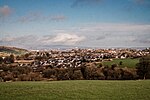Craighall Reservoir

Craighall Reservoir, known locally as Craighall Dam, is one of a number of small reservoirs, situated around Neilston in East Renfrewshire, Scotland. The reservoir is located on the western slopes of Neilston Pad and has a number of well maintained public access paths. As of August 2020 it has an area of 5.9 hectares (0.059 km2).The reservoir was constructed in 1817 to store flood water that would ensure a constant supply of water to bleach works situated on Kirkton Burn. The reservoir flows into Craig Burn, a small stream which runs along the western side of Neilston Pad, past Craig o' Neilston farm before joining Kirkton Burn. It first appeared on Ordnance Survey maps in 1856.The reservoir is owned by Elderslie Estates.
Excerpt from the Wikipedia article Craighall Reservoir (License: CC BY-SA 3.0, Authors, Images).Craighall Reservoir
Kingston Road,
Geographical coordinates (GPS) Address Nearby Places Show on map
Geographical coordinates (GPS)
| Latitude | Longitude |
|---|---|
| N 55.764117 ° | E -4.437777 ° |
Address
Kingston Road
KA3 4EQ
Scotland, United Kingdom
Open on Google Maps






